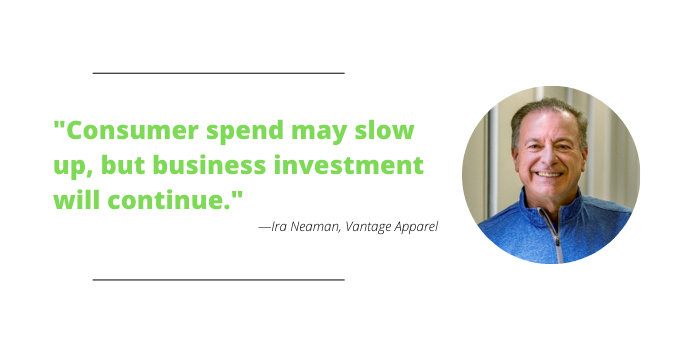Despite Economic Concerns In Some Sectors, Promo Finds A Fertile Market In 2022

Concerns over an economic downturn are rising among some business leaders. In its latest Emerging Risks Report, drawing from a survey of 330 senior executives in first quarter 2022, research firm Gartner notes that a macroeconomic downturn has moved into their top five risks. Closer to home, the promo industry is bucking this trend with a strong start in 2022 and plenty of reasons to be optimistic about the year ahead.
The Promo Perspective: Regardless of Gartner’s survey findings, indicators out of the promotional products industry point to healthy market conditions. This month, industry service provider and PPAI technology partner SAGE published its Q1 2022 Global Statistical Report, highlighting data drawn from distributor activity on its systems. The findings were encouraging.
- The promo marketplace is off to a strong start in 2022, with monthly average search volume up, year over year, between 24% and 28% for the first free months of the year.
- March’s search volume of 1.42 million searches almost matched 2019’s pre-pandemic figure of 1.43 million.
- Following a dip in Q4 2021, quarterly search totals have trended steadily upward over the past 15 months.
- In Q1, a PPAI survey of industry distributors revealed that nearly 70% expect higher sales and profit for 2022.
An Emerging Risk: An economic downturn ranked among the top five emerging risks in Gartner’s first quarter 2022 survey. This is the first time concerns about a downturn have reached the survey’s top five, but the issue still trails new ransomware models, post-pandemic talent, supply chain disruptions and inflationary pressures in the survey.
.@Gartner_Legal survey shows #risk of economic #downturn rising among executive concerns. Read the press release here: https://t.co/bXFJkc4Mdu.
— Gartner for Legal, Risk & Compliance (@Gartner_Legal) April 21, 2022
Gartner attributes growing concerns over a macroeconomic downturn to three key root causes that have driven it towards the forefront of executives’ minds:
- Central Bank rate hikes – The Federal Reserve and other major central banks have taken a hawkish stance that has driven concerns about a market correction and lower overall liquidity in global markets.
- Russia’s invasion of Ukraine – Fears of contagion effects have grown as the war continues and has driven higher-level concerns about a global economic reset and the unpredictable effects of deglobalization.
- COVID-19 variants – The persistent presence of COVID-19 and potential for new variants continues to limit global market access and restrict economic growth.
Concerns over the economy register most acutely in some of the most economically sensitive sectors, including consumer discretionary, basic materials and financial services, where 75% or more of industry respondents indicated it as a top risk. The economic downturn risk was ranked highest regionally in the Asia Pacific region.
On Thursday, the U.S. Commerce Department reported that in Q1, the U.S. economy contracted 1.4%, a sharp reversal from the previous quarter’s 6.9% growth. The report pegs declining inventories, exports and government spending as significant factors in the contraction. Economists, however, downplay fears of recession, pointing to strong consumer spending and business investment in Q1.
Don't freak out about the GDP report, the underlying inertial components were strong.
— Jason Furman (@jasonfurman) April 28, 2022
The headline was -1.4% growth at an annual rate.
BUT, inventories subtracted 0.8pp and net exports subtracted 3.2pp.
Consumption, fixed investment, and key domestic demand components strong.
In Their Words: Matt Shinkman, vice president with the Gartner Legal, Risk & Compliance practice, says, “The macroeconomic environment was already challenging before Russia’s invasion of Ukraine, marked by persistent inflation and supply chain bottlenecks, which remain largely unresolved. Executives now face a spread of risks that are difficult to plan against, including contagion effects from war in Europe, aggressive central bank tightening and continued COVID-19 pressure on growth in major global markets.”
He adds, “ERM leaders must work with their business partners to reset many assumptions that occurred before the outbreak of war and confirmation of aggressive quantitative tightening. Without adjusting plans for these new realities, organizations face an appetite risk balance that could see them taking either too much risk, or otherwise being unprepared for opportunities presented by a downturn.”
Promo Reaction: The same healthy performance born out by statistics from PPAI and SAGE is visible on the ground to industry practitioners.
“I feel like the post-pandemic economic recovery remains strong and that our industry will continue to see steady growth,” says Brian Jolin, MAS, owner of Fort Worth, Texas, distributor Jolin Promo. “Continued inflation is not going to be as much of a concern once supply chains issues and freight costs are stabilized.”

Promotional products’ value to marketers means the industry’s fortunes are not always impacted in the same ways as other parts of the economy or other advertising media. Ira Neaman, MAS, president and CEO of Avenel, New Jersey, supplier Vantage Apparel, says, “Promotional products are very efficient in terms of what they accomplish. They’ve proven on a ROI or cost-per-impression basis to be very effective. It’s non-intrusive. It’s B2B as opposed to B2C. People’s savings can erode, but business investment will still go on.
“Consumer spend may slow up, but business investment will continue.”
Thomas Goos, MAS, president of Kirkland, Washington-based distributor Image Source, says, “I believe the current economy continues to be good; we see strong demand even with all the adversity around supply chain challenges and staffing constraints. There are a lot of headwinds ahead with inflation, rising interest rates, fuel costs and still some instability around COVID concerns. Live events are starting to resume, but not at the numbers I would have hoped.”
Looking Ahead: Jolin sees plenty of signs pointing to a bright future for the industry. He says, “I am very optimistic because I see my clients in a variety of industries starting to really thrive again. Events are back, however the focus seems to be on quality events over quantity. If business travel is down, leisure is up based on prices for hotels in places I travel for both.
“Merch spends are up as companies are wanting to attract and retain employees and nonprofits are wanting to spread their message and thank their volunteers.”

